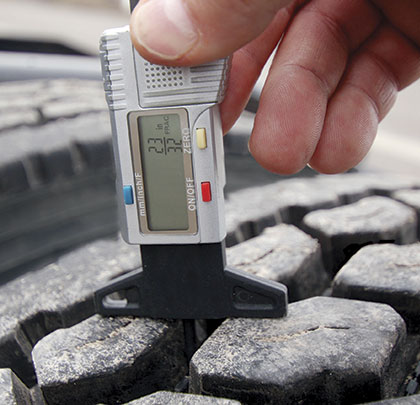Long tire life starts with selecting the correct tires for your vehicle and maintaining them throughout their life. The type of tires contractors need depends on the type of fleet they operate and the service application. Having the proper tires and an effective tire maintenance program can help keep drivers safe, avoid costly downtime, and reduce operational costs.
TIRE SELECTION
In construction applications, it is best to use mixed-service tires with deep treads and cut/chip resistant tread compounds. These tires will resist cutting and tearing from gravel or debris and they have heavy sidewalls that resist damage from larger objects. The Roadmaster RM300HH features a deep lug pattern to provide excellent driving traction and durability.
In some operations, dump trucks can spend a surprisingly high proportion of their time and mileage on the road rather than on jobsites. In these cases, open-shoulder drive tires designed for pick-up and delivery service may be the better choice, such as the Roadmaster RM254. These types of tires deliver longer tread wear since they are designed for highway use and are resistant to scrubbing.
A tire designed for long haul trucks will not necessarily perform well in a mixed service application. Many tires that are used in both paved highway and some gravel roads, or even off road use, require a different tread design and more cut/chip resistant tread to offer the best performance.
Tread designs that resist stone retention are also an advantage in avoiding stone drilling and casing damage. Make sure that the tire load capacity matches the axle weight on your trucks. Mud traction or snow traction may be needed, which will influence the tread design.
TIRE MAINTENANCE
Since tires are often the biggest operating expense after fuel, a lot of money is riding on a vehicle’s wheels. After all, a typical tractor/trailer runs 18 wheel positions. The owner’s investment in tires is worth protecting, and it’s worth knowing how to maximize performance based on operational and maintenance factors. There are a number of things that should be monitored regularly, including proper tire inflation, routine tire rotation, irregular wear, and tire casing integrity.
PROPER TIRE INFLATION
Maintaining proper inflation pressure in tires is the single most important factor in extending tire life. Both over and under inflation have negative effects on the tire by changing its footprint, which is the area contacting the road. Under inflation can cause excessive heat buildup and can potentially cause internal structural damage. Over inflation can make tires more vulnerable to cutting, punctures, or damage from sudden impacts. When the tire is not contacting the road as the tire design intended, the tread area will also wear irregularly and therefore more rapidly. Correct inflation pressure is determined by the load carried for each tire.

Featured Image: A depth gauge is used to check tire tread wear.
Above: A pressure gauge keeps the proper tire inflation in check.
ROUTINE TIRE ROTATION
Routinely rotating the tires directly contributes to longer tire life, especially in areas of irregular tread wear. Tire rotation can often improve tire wear, because when there is a change in the direction of the rotation or when cross-rotating the tires, some irregular wear can be improved.
Roadmaster recommends rotating tires when they are 50 percent worn, or even earlier if they show signs of irregular wear. Changing the direction of rotation also can even out heel/toe wear on the shoulders of drive tires and erratic wear on the shoulders of trailer tires. Steer tires are normally rotated side-to-side, which changes the direction of rotation and helps even out wear. At a 3/32-inch to 4/32-inch difference in tread depth between the drive axle tires, a cross-rotation would be recommended to even out the wear and increase tire life before removal.
Directional tires are the only tires that should not change the direction of rotation. Drivers of trucks with dual drive axles perform a tire rotation if the wear gets to 3/32nds of an inch to 4/32nds of an inch difference from axle to axle. If irregular wear is noticed, a cause must be determined and the situation resolved.
CHECK FOR IRREGULAR WEAR
While rotating tires can help even out irregular wear, you still need to investigate what is causing the issue. Irregular wear conditions will lead to premature tire removals. When tires are not wearing evenly, fuel economy will drop. Eventually, irregular wear reduces mileage and increases costs, as the need to replace tires becomes more frequent. Irregular wear also causes vibration and ride disturbances.
TIRE CASING INTEGRITY
Choosing the correct tire for your needs, maintaining air pressure, tire rotation, and checking wear are integral to preserving tire casing integrity. Other factors include tire performance characteristics such as fuel economy, durability, traction, miles to removal, safety and price, as well as casing retreadability.
At Roadmaster, we believe in order to get the most out of your tires, it’s important to find a tire that will provide long miles to removal, as well as one that takes into account the casing quality and belt package. The casing quality will tell you a great deal about the tire—how it will hold up and the value the tire has for its second and third life in retreading. All Roadmaster tires are engineered for retreadability and are backed with a strong warranty of two retreads within 6 years. ■
About the Author: Gary Schroeder is director of Cooper Tire & Rubber Company’s truck and bus tire business. Cooper Tire & Rubber Company is the parent company of a global family of companies that specializes in the design, manufacture, marketing and sale of passenger car, light truck, medium truck, motorcycle and racing tires. For more information, visit www.coopertire.com.
_________________________________________________________________________
Modern Contractor Solutions, February 2017
Did you enjoy this article?
Subscribe to the FREE Digital Edition of Modern Contractor Solutions magazine.

Tire Selection and Proper Maintenance Lead to Long Tire Life


